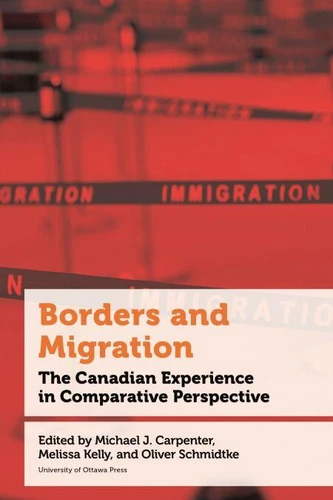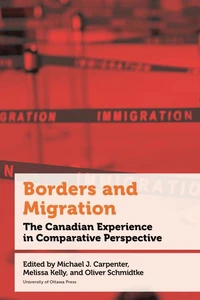Borders and Migration. The Canadian Experience in Comparative Perspective
Par : , , , ,Formats :
Disponible dans votre compte client Decitre ou Furet du Nord dès validation de votre commande. Le format ePub est :
- Compatible avec une lecture sur My Vivlio (smartphone, tablette, ordinateur)
- Compatible avec une lecture sur liseuses Vivlio
- Pour les liseuses autres que Vivlio, vous devez utiliser le logiciel Adobe Digital Edition. Non compatible avec la lecture sur les liseuses Kindle, Remarkable et Sony
 , qui est-ce ?
, qui est-ce ?Notre partenaire de plateforme de lecture numérique où vous retrouverez l'ensemble de vos ebooks gratuitement
Pour en savoir plus sur nos ebooks, consultez notre aide en ligne ici
- Nombre de pages372
- FormatePub
- ISBN978-0-7766-3808-9
- EAN9780776638089
- Date de parution10/01/2023
- Protection num.pas de protection
- Taille4 Mo
- Infos supplémentairesepub
- ÉditeurUniversity of Ottawa Press
Résumé
Since 2015, the cross-border movement of migrants and refugees has reached unprecedented levels. War, persecution, destitution, and desertification impelled millions to flee their homes in central Asia, the Levant, and North Africa. The responses in the Global North varied country by country, with some opening their borders to historically large numbers of refugees and asylum seekers, while others adopted increasingly strict border policies.
The dramatic increase in global migration has triggered controversial political and scholarly debates. The governance of cross-border mobility constitutes one of the key policy conundrums of the 21st century, raising fundamental questions about human rights, state responsibility, and security. The research literatures on borders and migration have rapidly expanded to meet the increased urgency of record numbers of displaced people.
Yet, border studies have conventionally paid little attention to flows of people, and migration studies have simultaneously underappreciated the changing nature of borders. Borders and Migration: The Canadian Experience in Comparative Perspective provides new insights into how migration is affected by border governance and vice versa. Starting from the Canadian experience, and with an emphasis on refugees and irregular migrants, this multidisciplinary book explores how various levels of governance have facilitated and restricted flows of people across international borders.
The book sheds light on the changing governance of migration and borders. Comparisons between Canada and other parts of the world bring into relief contemporary trends and challenges. Available formats: hardcover, trade paperback, accessible PDF, and accessible ePub
The dramatic increase in global migration has triggered controversial political and scholarly debates. The governance of cross-border mobility constitutes one of the key policy conundrums of the 21st century, raising fundamental questions about human rights, state responsibility, and security. The research literatures on borders and migration have rapidly expanded to meet the increased urgency of record numbers of displaced people.
Yet, border studies have conventionally paid little attention to flows of people, and migration studies have simultaneously underappreciated the changing nature of borders. Borders and Migration: The Canadian Experience in Comparative Perspective provides new insights into how migration is affected by border governance and vice versa. Starting from the Canadian experience, and with an emphasis on refugees and irregular migrants, this multidisciplinary book explores how various levels of governance have facilitated and restricted flows of people across international borders.
The book sheds light on the changing governance of migration and borders. Comparisons between Canada and other parts of the world bring into relief contemporary trends and challenges. Available formats: hardcover, trade paperback, accessible PDF, and accessible ePub
Since 2015, the cross-border movement of migrants and refugees has reached unprecedented levels. War, persecution, destitution, and desertification impelled millions to flee their homes in central Asia, the Levant, and North Africa. The responses in the Global North varied country by country, with some opening their borders to historically large numbers of refugees and asylum seekers, while others adopted increasingly strict border policies.
The dramatic increase in global migration has triggered controversial political and scholarly debates. The governance of cross-border mobility constitutes one of the key policy conundrums of the 21st century, raising fundamental questions about human rights, state responsibility, and security. The research literatures on borders and migration have rapidly expanded to meet the increased urgency of record numbers of displaced people.
Yet, border studies have conventionally paid little attention to flows of people, and migration studies have simultaneously underappreciated the changing nature of borders. Borders and Migration: The Canadian Experience in Comparative Perspective provides new insights into how migration is affected by border governance and vice versa. Starting from the Canadian experience, and with an emphasis on refugees and irregular migrants, this multidisciplinary book explores how various levels of governance have facilitated and restricted flows of people across international borders.
The book sheds light on the changing governance of migration and borders. Comparisons between Canada and other parts of the world bring into relief contemporary trends and challenges. Available formats: hardcover, trade paperback, accessible PDF, and accessible ePub
The dramatic increase in global migration has triggered controversial political and scholarly debates. The governance of cross-border mobility constitutes one of the key policy conundrums of the 21st century, raising fundamental questions about human rights, state responsibility, and security. The research literatures on borders and migration have rapidly expanded to meet the increased urgency of record numbers of displaced people.
Yet, border studies have conventionally paid little attention to flows of people, and migration studies have simultaneously underappreciated the changing nature of borders. Borders and Migration: The Canadian Experience in Comparative Perspective provides new insights into how migration is affected by border governance and vice versa. Starting from the Canadian experience, and with an emphasis on refugees and irregular migrants, this multidisciplinary book explores how various levels of governance have facilitated and restricted flows of people across international borders.
The book sheds light on the changing governance of migration and borders. Comparisons between Canada and other parts of the world bring into relief contemporary trends and challenges. Available formats: hardcover, trade paperback, accessible PDF, and accessible ePub




